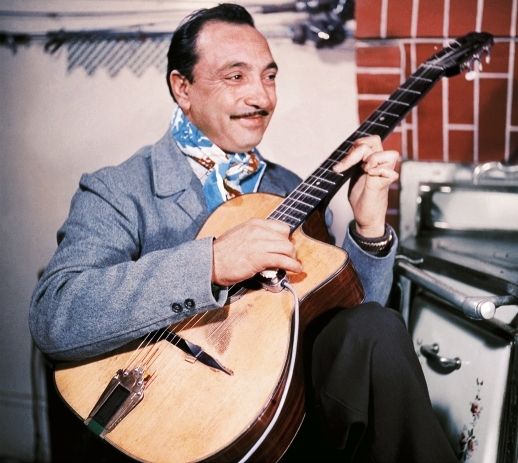Aidan Curran posted on June 29, 2007 08:09
First things first: we must shatter a popular myth - Django Reinhardt never lost any fingers. For all of his life he had the full set of ten. Look at the picture below right and count them (okay, so you can't see his thumbs).
 However, what is true is that, because of injuries he sustained in a fire when he was 18, two fingers of his left hand were badly withered (due to the same incident his right leg was so badly damaged that he had to use a cane for the rest of his life). Although he depended on his two left forefingers to do nearly all his fretwork, he occasionally could use the two damaged fingers.
However, what is true is that, because of injuries he sustained in a fire when he was 18, two fingers of his left hand were badly withered (due to the same incident his right leg was so badly damaged that he had to use a cane for the rest of his life). Although he depended on his two left forefingers to do nearly all his fretwork, he occasionally could use the two damaged fingers.
Disability was not the only obstacle Django had to overcome. He was a gypsy at a time (the Nazi occupation of France) when many gypsies were deported to concentration camps (the Third Reich tolerated neither ethnic minorities nor jazz). He escaped to Britain during the war with the help of a Luftwaffe officer called Dietrich Schulz-Kohn (known to his friends as 'Doktor Jazz') who was a huge fan of Reinhardt and his music. After the war he returned to France and his encampment to the north of Paris - today if you take the train between Charles de Gaulle Airport and Paris, you'll still see modern gypsy camps in the same area near the Stade de France.
Reinhardt never adapted to modern life nor sought to join the settled community. Happily for him, the modern world would, out of admiration for his astounding music, often adapt itself to him. One of our favourite Django stories (and there are loads out there) tells of the time that the Belgian royal family, huge fans of his music, invited him to dinner in their palace in Brussels. When salad was served Django ignored the cutlery and began eating with his fingers. After several seconds of stunned silence the royals, not wanting to offend him, also began eating their salad with their fingers.
Reinhardt lived his final years in Samois-sur-Seine, outside Paris, and this weekend the town honours him by hosting its annual festival of the 'jazz manouche' (or gypsy jazz) style he defined.
Django's most famous works are those from his time with the 'Hot Club de Paris', the group he and violinist Stephane Grapelli played with in the jazz bars of Saint-Germain. The recordings that Reinhardt and Grapelli made are essential listening and continue to influence artists of all genres. In particular, we loved the Hot Club Of Cowtown, a Texan trio (now split up, unfortunately) that mixed jazz manouche with country swing. Strangely enough, the English band called Hot Club De Paris plays indie-rock.
From the rare surviving footage of Django in action, here's 'J'Attendrai':
More ...
[Read More...]